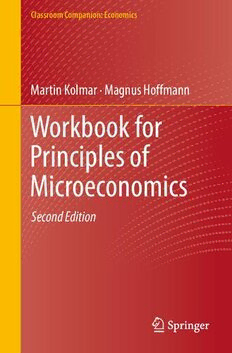Table Of ContentClassroom Companion: Economics
Martin Kolmar · Magnus Hoffmann
Workbook for
Principles of
Microeconomics
Second Edition
Classroom Companion: Economics
The Classroom Companion series in Economics features fundamental textbooks
aimedatintroducingstudentstothecoreconcepts,empiricalmethods,theoriesand
tools of the subject. The books offer a firm foundation for students preparing to
movetowardsadvancedlearning.Eachbookfollowsacleardidacticstructureand
presentseasyadoptionopportunitiesforlecturers.
Moreinformationaboutthisseriesathttp://www.springer.com/series/16375
Martin Kolmar • Magnus Hoffmann
Workbook for Principles
of Microeconomics
Second Edition
MartinKolmar MagnusHoffmann
DepartmentofEconomics DepartmentofEconomics
UniversityofSt.Gallen UniversityofSt.Gallen
St.Gallen,Switzerland St.Gallen,Switzerland
ISSN2662-2882 ISSN2662-2890 (electronic)
ClassroomCompanion:Economics
ISBN978-3-030-87727-9 ISBN978-3-030-87728-6 (eBook)
https://doi.org/10.1007/978-3-030-87728-6
©SpringerNatureSwitzerlandAG2022
Thisworkissubjecttocopyright.AllrightsarereservedbythePublisher,whetherthewholeorpartof
thematerialisconcerned,specificallytherightsoftranslation,reprinting,reuseofillustrations,recitation,
broadcasting,reproductiononmicrofilmsorinanyotherphysicalway,andtransmissionorinformation
storageandretrieval,electronicadaptation,computersoftware,orbysimilarordissimilarmethodology
nowknownorhereafterdeveloped.
Theuseofgeneraldescriptivenames,registerednames,trademarks,servicemarks,etc.inthispublication
doesnotimply,evenintheabsenceofaspecificstatement,thatsuchnamesareexemptfromtherelevant
protectivelawsandregulationsandthereforefreeforgeneraluse.
Thepublisher,theauthors,andtheeditorsaresafetoassumethattheadviceandinformationinthisbook
arebelievedtobetrueandaccurateatthedateofpublication.Neitherthepublishernortheauthorsor
theeditorsgiveawarranty,expressedorimplied,withrespecttothematerialcontainedhereinorforany
errorsoromissionsthatmayhavebeenmade.Thepublisherremainsneutralwithregardtojurisdictional
claimsinpublishedmapsandinstitutionalaffiliations.
ThisSpringerimprintispublishedbytheregisteredcompanySpringerNatureSwitzerlandAG.
Theregisteredcompanyaddressis:Gewerbestrasse11,6330Cham,Switzerland
Foreword to the SecondEdition
After4years,itistimetofundamentallyexpandandrevisethetextbookonwhich
this workbook is based. This also necessitated an expansion and revision of this
workbook.
Thepresenteditionretainstheprovenstructurebasedonthreetypesofexercises,
includingsamplesolutions.Inparticular,tasksthatshedmorelightontheeconomic
and methodological contexts of the theories have been newly developed and
integratedintothisbook.Furthermore,therearetasksandsamplesolutionsforthe
new chapters in the textbook. They cover (1) traditional decision theories under
riskanduncertainty,(2)behavioraleconomics,and(3)neuroscience,evolutionary
psychology,and narrative psychology.More detailed instructions can be found in
the forewordto the first edition. However, it should be noted at this point that all
referencestochaptersaretothoseinthetextbook“PrinciplesofMicroeconomics:
AnIntegrativeApproach”byMartinKolmar,unlessotherwisespecified.
We thankCorinneKnöpfel,JanRiss, andJanSerwartforco-authoringsomeof
theproblemsets.WealsowouldliketothankJudithGampforhercriticalcomments
and careful review of the manuscript. Thanks are also due to Yara Locher, who
helped us preparing the graphics. Jürg Furrer, Stefan Legge, and Alfonso Sousa-
Pozaarealsothankedfortheirmanyconstructivecomments.
Also, we would like to thank the many students whose numerous notes and
commentsovertheyearshavefoundtheirwayintothisbook.
St.Gallen,Switzerland MagnusHoffmann
St.Gallen,Switzerland MartinKolmar
February2021
v
Foreword to the First Edition
If you want to learn the piano, you have to sit down and start practicing. This
is tedious in the beginning and will not sound particularly pretty, but things will
improve over time. The same applies to economics (and other scientific theories
as well). If youwant to use them to better understandand analyze certain aspects
of economic and social reality, you have to make them your own, understand
theirinternal“mechanics,”andworkwith them.Readingtextbooksorlisteningto
lecturesis onlya poorsubstitute. Limitingyourselfto it would be like wantingto
learnhowtoplaypianobyjustlisteningtoapianoplayerandstudyingpianoscores.
Thisiswhywehavecollectedaseriesofproblemsandexercisesthatareintended
to help you to adopt step by step the theories introduced and discussed in the
textbook“PrinciplesofMicroeconomics:An IntegrativeApproach.”Youwillfind
a chapter with different types of problems and sample solutions that correspond
to a chapter in the main book. We distinguish between three different types of
exercisesthat focus on the developmentof specific and complementaryskills and
competencies.
Thefirsttypeistrueorfalseexercises;statementsthatcanbeeithertrueorfalse.
Attheendofeachsection,youwillfindthesolutionsalongwithshortexplanations,
aswellaslinkstothetextbook.
The second type of problems have the character of short case studies or word
problems, to answer which you are will be required to develop a more complex
trainofthoughts.Problemslikethesedonothaveoneandonlyonecorrectsolution
but can usually be approached from different directions. Nevertheless, this book
offers you sample solutions at the end of this section that illustrate one possible
approach.Over the yearsduringwhichwe havedevelopedthe problemsandused
them in class, we have also been able to identifytypicallines offaulty reasoning.
Wewilllookintotheseandexplainhowtheycanbeavoided.
Finally,youwillfindmultiple-choicequestionstoanswerinwhichyouwillhave
toidentifyonecorrectanswerfromachoiceofgivenanswers.Please notethatall
referencestochaptersaretothoseinthetextbook“PrinciplesofMicroeconomics:
AnIntegrativeApproach”byMartinKolmar,unlessotherwisespecified.
Theteachingmaterialcollectedinthisbookhasgrownovermanyyearsandisa
resultofeffortsofgreatmanypeople,firstofallthestudentswhoworkedwiththem.
Wearemostthankfulfortheirinnumerablesuggestionsthathelpedusimprovingthe
vii
viii ForewordtotheFirstEdition
set of problems. Further, we thank Dario Fauceglia, Jürg Furrer, Carolin Güssow,
KatharinaHofer,AlfonsoSousa-Poza,andFredHennebergerforpointingoutmany
errors, inconsistencies, and ways to improve the problems included in this book.
Last butnotleast, we thankour studentassistants Corinne Knöpfel,Jan Riss, and
JanSerwartwithoutwhomthebookwouldnotbeasitis.
Sciencethataimsatbetterunderstandingboththerealityandpracticalapplica-
tionoftheoryissimilartojazz.Agoodeconomistislikeagoodpianist:bothhave
tomastertheirinstrumentstobeabletoimprovise.Youknowyouarethere,when
itstartstoswing.Wehopethatthisbookwillhelpyouonyourwaytoreachingthis
goal.
St.Gallen,Switzerland MagnusHoffmann
St.Gallen,Switzerland MartinKolmar
July2017
Contents
1 FirstPrinciples.............................................................. 1
1.1 TrueorFalse.......................................................... 1
1.1.1 Statements .................................................. 1
1.1.2 Solutions.................................................... 4
1.2 OpenQuestions....................................................... 8
1.2.1 Problems.................................................... 8
1.2.2 Solution ..................................................... 9
2 GainsfromTrade........................................................... 11
2.1 TrueorFalse.......................................................... 11
2.1.1 Statements .................................................. 11
2.1.2 Solutions.................................................... 13
2.2 OpenQuestions....................................................... 17
2.2.1 Problems.................................................... 17
2.2.2 Solutions.................................................... 18
2.3 MultipleChoice ...................................................... 26
2.3.1 Problems.................................................... 26
2.3.2 Solutions.................................................... 32
3 MarketsandInstitutions:Introduction.................................. 35
3.1 TrueorFalse.......................................................... 35
3.1.1 Statements .................................................. 35
3.1.2 Solutions.................................................... 36
3.2 OpenQuestions....................................................... 38
3.2.1 Problems.................................................... 38
3.2.2 Solutions.................................................... 38
4 SupplyandDemand........................................................ 41
4.1 TrueorFalse.......................................................... 41
4.1.1 Statements .................................................. 41
4.1.2 Solutions.................................................... 43
4.2 OpenQuestions....................................................... 45
4.2.1 Problems.................................................... 45
4.2.2 Solutions.................................................... 48
ix
x Contents
4.3 MultipleChoice ...................................................... 59
4.3.1 Problems.................................................... 59
4.3.2 Solutions.................................................... 60
5 NormativeEconomics...................................................... 61
5.1 TrueorFalse.......................................................... 61
5.1.1 Statements .................................................. 61
5.1.2 Solutions.................................................... 63
5.2 OpenQuestions....................................................... 65
5.2.1 Problems.................................................... 65
5.2.2 Solutions.................................................... 67
6 ExternalitiesandtheLimitsofMarkets ................................. 71
6.1 TrueorFalse.......................................................... 71
6.1.1 Statements .................................................. 71
6.1.2 Solutions.................................................... 75
6.2 OpenQuestions....................................................... 81
6.2.1 Problems.................................................... 81
6.2.2 Solutions.................................................... 85
6.3 MultipleChoice ...................................................... 101
6.3.1 Problems.................................................... 101
6.3.2 Solutions.................................................... 106
7 DecisionsandConsumerBehavior ....................................... 109
7.1 TrueorFalse.......................................................... 109
7.1.1 Statements .................................................. 109
7.1.2 SampleSolutions........................................... 111
7.2 OpenQuestions....................................................... 116
7.2.1 Problems.................................................... 116
7.2.2 Solutions.................................................... 117
7.3 MultipleChoice ...................................................... 120
7.3.1 Problems.................................................... 120
7.3.2 Solutions.................................................... 122
8 DecisionsUnderUncertaintyandRisk................................... 125
8.1 TrueorFalse.......................................................... 125
8.1.1 Statements .................................................. 125
8.1.2 Solutions.................................................... 127
8.2 OpenQuestions....................................................... 131
8.2.1 Problems.................................................... 131
8.2.2 Solutions.................................................... 132
8.3 MultipleChoice ...................................................... 136
8.3.1 Problems.................................................... 136
8.3.2 Solutions.................................................... 138

